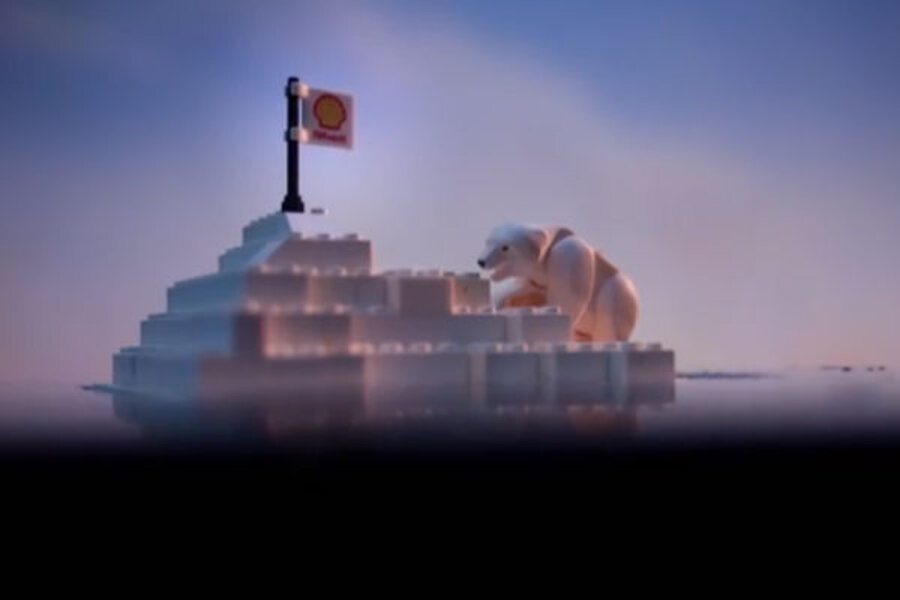How did Greenpeace get LEGO to ditch Shell play sets?
Loading...
LEGO, the popular children's toy company, has announced that it will end a lucrative marketing partnership with fossil-fuel giant Royal Dutch Shell this year, following a months-long campaign by environmental group Greenpeace.
The Greenpeace campaign targeted LEGO's partnership with Shell as a means to criticize the fuel company's ongoing plans to drill for oil in the Arctic. The focal point of the campaign was a short viral video depicting the Arctic, made from 265 pounds of LEGO, being covered with oil. The video attracted almost 6 million views on YouTube, and riffed on music and animation from "The LEGO Movie," one of the highest grossing films of the year.
It's a strategy that has been effective with other issues in the past. Greenpeace used a "Ken dumps Barbie" campaign to target Mattel, Inc. for its use of deforestation in its supply chain. Earlier this year, animal rights groups protested SeaWorld Entertainment's treatment of the theme park's captive orca by targeting Southwest Airlines' 26-year-old marketing relationship with SeaWorld. Leveraging the success of the 2013 documentary "Blackfish," which examined the treatment of captive orcas in SeaWorld and made over $2 million in the US box office, the pressure ultimately led to the two companies ending their relationship.
LEGO's partnership with Shell dates back to the 1960s, but the current three-year co-promotion contract between the two companies runs out at the end of this year. The 2012-14 partnership deal was valued at $116 million by Iris Worldwide, the advertising agency behind the deal, and allowed Lego to distribute toy sets in Shell gas stations in 26 different countries.
In a statement released yesterday, the chief executive officer of the Denmark-based LEGO Group, Jørgen Vig Knudstorp, praised the partnership as a way to deliver on the objective of "bringing LEGO bricks into the hands of many children," and said the company will honor the remainder of the three-year contract.
Mr. Knudstorp added, however, "as things currently stand we will not renew the co-promotion contract with Shell when the present contract ends."
The Shell logo could be found on LEGO pieces for decades, and Shell-branded LEGO sets were sold into the 1990s before the company dropped the logo and switched to a fictional oil company called Octan. John Sauven, executive director of Greenpeace UK, told The Guardian that Shell is clearly "trying to piggy back on the credibility of other brands."
Mr. Sauven added that the success of the Greenpeace campaign is "a sign of changes that are happening" in public attitudes towards fossil-fuel companies.
Mark Borkowski, a brand consultant and founder of the PR company Borkowski.do, adds that the campaign's ability to appeal to the younger generation – "the custodians of the LEGO brand" – was a major factor in its success.
"It's a brand kids of every generation grew up with," Mr. Borkowski says.
"[The campaign] has really activated younger people, and it has activated younger people in a medium they understand," he adds. "These aren’t customers who are obsessed with legacy businesses. They’re becoming more and more and politicized, and I think this is the first time we've seen big oil and gas companies have to consider this."
LEGO initially resisted the Greenpeace campaign, citing the company's own environmental record and arguing that Greenpeace should have taken their complaints about Arctic drilling to Shell itself. In his statement, Knudstorp said that Greenpeace "uses the LEGO brand to target Shell," and that "the LEGO brand ... should never have become part of Greenpeace’s dispute with Shell."
But there is a specific reason why Greenpeace decided to use LEGO as a means to protest against Shell. The activist group has targeted Shell in the past – including flying a protest banner over the Belgian Grand Prix last year – but with little success.
Jim Lyza, a senior research analyst at the marketing agency Shelton Group, wrote in GreenBiz.com post in July that it's easier for Greenpeace to gain attention and grab social media traction "by leveraging a surprising, well-loved target like Lego."
In particular, Greenpeace is trying to target "concerned parents," Mr. Lyza added, a demographic that the Shelton Group describes as making up roughly one-third of the American market.
"Greenpeace is 'asking parents and LEGO fans to stand up for the Arctic and call on LEGO to cut ties with Shell,'" Lyza wrote.








